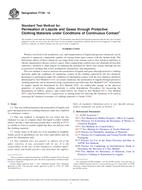Potřebujeme váš souhlas k využití jednotlivých dat, aby se vám mimo jiné mohly ukazovat informace týkající se vašich zájmů. Souhlas udělíte kliknutím na tlačítko „OK“.
ASTM F739-12
Standard Test Method for Permeation of Liquids and Gases through Protective Clothing Materials under Conditions of Continuous Contact
Automaticky přeložený název:
Standardní zkušební metoda pro permeaci kapalin a plynů prostřednictvím materiálů ochranných oděvů v podmínkách neustále v kontaktu
NORMA vydána dne 1.9.2012
Informace o normě:
Označení normy: ASTM F739-12
Poznámka: NEPLATNÁ
Datum vydání normy: 1.9.2012
Kód zboží: NS-56303
Počet stran: 13
Přibližná hmotnost: 39 g (0.09 liber)
Země: Americká technická norma
Kategorie: Technické normy ASTM
Anotace textu normy ASTM F739-12 :
Keywords:
permeation, protection clothing, protective clothing materials, ICS Number Code 13.340.10 (Protective clothing)
Doplňující informace
| Significance and Use | ||||||||||||||||||||||||||||||||
|
5.1 This test method is normally used to evaluate flat specimens from finished items of protective clothing and from materials that are candidates for items of protective clothing. 5.1.1 Finished items of protective clothing include gloves, arm shields, aprons, suits, hats, boots, respirators, and the like. 5.1.2 The phrase “specimens from finished items” encompasses seamed or other discontinuous regions as well as the usual continuous regions of protective clothing items. 5.2 The breakthrough detection time, standardized breakthrough time, permeation rate, and cumulative permeation are key measures of the effectiveness of a clothing material as a barrier to the test chemical. Such information is used in the comparison of clothing materials during the process of selecting clothing for protection from hazardous chemicals. Long breakthrough detection times, long standardized breakthrough detection times, low amounts of cumulative permeation, and low permeation rates are characteristics of better barriers. 5.2.1 The reporting of a
standardized breakthrough time greater than a specific time period
means that the test chemical has not permeated the specimen at a
rate exceeding 0.1 μg/cm2/min in the designated time.
Permeation may or may not have occurred at a lower rate during this
time interval.
5.3 The sensitivity of the test method in detecting low permeation rates or amounts of the test chemical that permeate is determined by the combination of the analytical technique and collection system selected, and the ratio of material specimen area to collection medium volume or flow rate. 5.3.1 The analytical technique employed should be capable of measuring the concentration of the test chemical in the collection medium at, or below, levels consistent with the standardized breakthrough time value specified in 5.3.2 Often permeation tests will require measurement of the test chemical over several orders of magnitude in concentration, requiring adjustments in either the sample collection volume or concentration/dilution, or the analytical instrument settings over the course of the test. 5.3.3 Higher ratios of material specimen area to collection medium volume or flow rate permit earlier detection of breakthrough and detection of lower permeation rates and levels of cumulative permeation because higher concentrations of the test chemical in the collection medium will develop in a given time period, relative to those that would occur at lower ratios. 5.4 Comparison of results requires specific information on the test cell, procedures, and analytical techniques. Results obtained from closed-loop and open-loop testing may not be directly comparable. 5.4.1 The sensitivity of an open-loop system is characterized by its minimum detectable permeation rate. A method for determining this value is presented in 5.4.2 The sensitivity of a closed-loop system is characterized by its minimum detectable mass permeated. 5.5 A group of chemicals for use in permeation testing is given in Guide F1001. 5.6 These test procedures are also a part of ISO 6529. ISO 6529 provides a harmonized standard that also permits using some practices commonly followed in Europe for permeation testing, for example, using a breakthrough time normalized at a permeation rate of 1.0 µg/cm2/min instead of 0.1µg/cm2/min as used in this method. For this reason, the reporting of all permeation data must include the method that is used in the testing. Guide F1194 provides guidance on reporting permeation test results. |
||||||||||||||||||||||||||||||||
| 1. Scope | ||||||||||||||||||||||||||||||||
|
1.1 This test method measures the permeation of liquids and gases through protective clothing materials under the condition of continuous contact. 1.2 This test method is designed for use when the test chemical is a gas or a liquid, where the liquid is either volatile (that is, having a vapor pressure greater than 1 mm Hg at 25°C) or soluble in water or another liquid that does not interact with the clothing material. 1.3 Values states in SI units are to be regarded as standard. Values given in parentheses are not exact equivalents and are given for information only. 1.4 This standard does not purport to address all of the safety concerns, if any, associated with its use. It is the responsibility of the user of this standard to establish appropriate safety and health practices and determine the applicability of regulatory limitations prior to use. Specific precautionary statements are given in Section 7. |
||||||||||||||||||||||||||||||||
| 2. Referenced Documents | ||||||||||||||||||||||||||||||||
|
Doporučujeme:
Aktualizace technických norem
Chcete mít jistotu, že používáte pouze platné technické normy?
Nabízíme Vám řešení, které Vám zajistí měsíční přehled o aktuálnosti norem, které používáte.
Chcete vědět více informací? Podívejte se na tuto stránku.




 Cookies
Cookies
